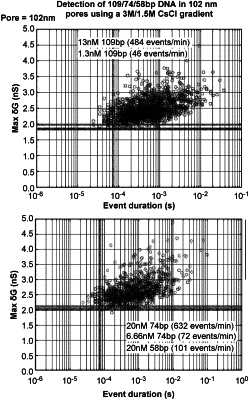| CPC G01N 27/44747 (2013.01) [C12Q 1/6806 (2013.01)] | 42 Claims |

|
1. A method for detecting or characterization of a polynucleotide in a sample within a nanopore device comprising:
a. contacting a sample suspected of comprising a polynucleotide with a sensing solution comprising an effective amount of a polyether agent of Formula (I):
 wherein:
m is 1-3;
n is 1-30;
each R1 is independently H or methyl; and
R2 and R3 are each independently H or C(1-6)alkyl,
wherein the sensing solution is contacting a nanoporous membrane of a nanopore device, wherein the nanoporous membrane separates the space of the nanopore device into a cis volume and a trans volume;
b. applying a voltage across a nanopore of the nanoporous membrane thereby inducing translocation of the polynucleotide through the nanoporous membrane; and
c. detecting a current during the translocation of the polynucleotide in the nanopore device; and
(d) characterizing the polynucleotide as having a length of less than 500 base pairs (bps), wherein the nanopore device containing the sensing solution allows for discrimination of the polynucleotide by size.
|